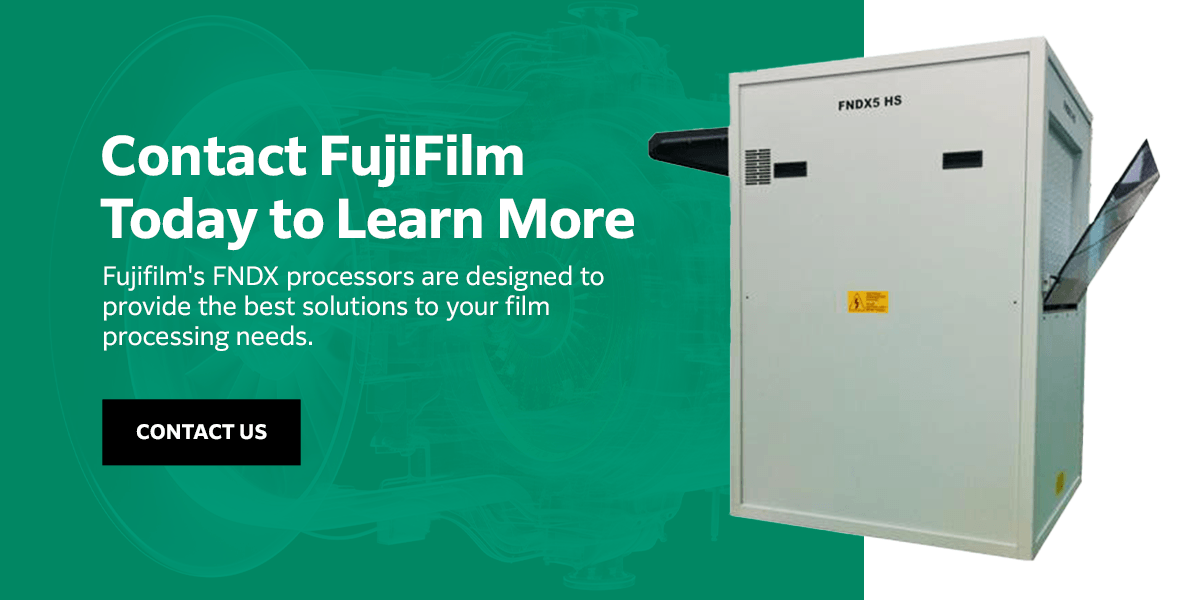What Is Automatic Film Processing?

Film processing is integral to non-destructive testing (NDT), especially in the aerospace and oil and gas industries. It allows for clear reading and analysis of test results, making latent X-ray scans visible. The challenge is that conventional processing methods are prone to human errors and delays. In contrast, automatic film processing machines have gained popularity across various industries. Learn more about how automatic processing works, how it’s different from manual processing, and why you might want to invest in an automatic film processor.
What Is Automatic Film Processing?
Automatic film processing is an automated process for developing film. Unlike manual film processing, a machine handles the entire chemical process, including developing, fixing, washing and drying. Several industries, including aerospace and oil and gas, use this method for non-destructive testing.
An electromechanical device called the automatic film processor transports an X-ray film from one solution to another at precise temperatures and for exact durations. It also monitors and adjusts the chemical levels without manual intervention, improving film quality and processing times.
Automatic film processors work using rollers, chains, gears and sprockets. The film is inserted into the machine at one end, transported by the roller system, and comes out through the other end of the processor, ready for viewing.
What Is the Difference Between Manual and Automatic Film Processing?
Manual film processing involves the movement of film from one solution to another through manual efforts, which is labor-intensive and time-consuming. The process can also result in variations, making it less ideal for diagnostic imaging. Manual film processing involves multiple stages, including the following:
- Wetting agent: The chemical loosens the emulsion, allowing subsequent solutions to reach all other parts. It’s an optional step because the emulsion can soften during development.
- Development: A developer solution converts latent images into a visible image. The developer is an essential part of the process.
- Stop bath or water rinse: This stops the development process and removes excess developer from the film.
- Fixing: Fixer solution removes the undeveloped and unexposed silver halide crystal from the emulsion and hardens it for permanent storage.
- Washing: A wash removes excess fixer from the film before drying. This prevents hypertension, a process where the fixer components crystalize onto the firm surface.
- Drying: Prepares the firm for storage and viewing using an electric dryer or exposure to room air, but the electric dryer approach is faster. You may also apply a wetting agent to the film before drying for consistent drying and water spot prevention.
Automatic film processing eliminates manual labor from these stages. An automatic film processor controls all actions, including temperature regulation and chemical monitoring. It also adjusts solution levels and stores multiple cycle configurations for easy installation.

Aerospace and oil and gas organizations prefer automated film processes because they reduce processing times, improve consistency and uniformity, and increase the number of films processed within a given period. Automatic film processing makes radiography a reliable non-destructive testing method.
What Are the Advantages of Automatic Film Processing?
Here are some of the major advantages of automatic film processing in the aerospace and oil and gas industries:
1. Improved Image Quality and Accuracy
The automatic film processing machine is more accurate than the conventional manual technique. It eliminates human errors, resulting in fewer defects and more uniform film development. The images produced have enhanced detail and better quality, making them the preferred choice in most industries.
2. Adherence to NDT Specifications
Images processed using automated machines are accurate and of good quality. They are consistent, making it easy to comply with specific NDT requirements. High-resolution images offer better visualization and analysis of defects during non-destructive testing inspections.
3. Labor Reduction
Automatic machines can process film much faster than human workers can. They require little human intervention and are highly efficient. This increase in efficiency can also improve your bottom line. You can produce large volumes of images without errors and defects.
4. Cost Savings
Automatic film processors are excellent investments for every aerospace or oil and gas company. They reduce labor costs, minimize film processing times and increase production efficiency. These can save you lots of money in the long run.
For example, human errors delay production times and result in material waste over time. One machine can perform more tasks than many skilled workers combined, reducing wages, salaries and other associated benefits.
FNDX Auto Film Processor Series
The FNDX processor is a top-class automatic film processor developed by Fujifilm. It is designed to make your film-processing procedure more efficient. You can set specific temperatures, cycle times, replenishment rates and other parameters from an electronic display. You can also program automatic start and shutdown schedules.
The processor automatically senses how full the tanks are to keep them at appropriate levels. It also includes wash rack buffer rollers and water circulation pumps for efficient washing and high-quality film archiving. If your location experiences warm temperatures, you can connect a closed-loop chiller to the machine’s internal cooling loop.
The FNDX processor is available in two models — the FNDX5HS and FNDX9000.
- FNDX5HS: This mid-size machine processes film at 40 centimeters per minute. The dry-to-dry cycle time is approximately 7 minutes.
- FNDX9000: This larger processor operates at 50 centimeters per minute. Its developer, fixer and wash tanks can hold up to 23 liters, resulting in stable processing and higher efficiencies.
Both models have adjustable temperature controls from 18℃ to 43℃ and regeneration systems with automatic replenishment calculated from developed film volume. Both can accommodate sheet films up to 43 centimeters wide and roll films. Their differences are in their sizes, tank capacity, power supply and weight.
The FNDX series is compatible with the Autofeeder IX accessory, which automatically feeds mixed film sizes into the processors. It has control features like an operation mode indicator, a double sheet alarm and an interrupt cycle. The Autofeeder IX also has a unique shutter assembly, enabling access to the processor without exposing the film to light.
Contact FujiFilm Today to Learn More
Automatic film processing is used in aerospace and oil and gas applications for its numerous benefits. These machines produce high-quality, accurate and consistent images. Automatic film processors are also faster than conventional techniques and have exceptional cost-saving benefits.
Fujifilm’s FNDX processors are designed to provide the best solutions to your film processing needs. They streamline your NDTs, adding value to your bottom line. They are simple to use, reliable and high quality. Learn more about this cutting-edge technology by contacting us today!











